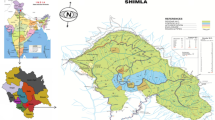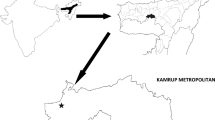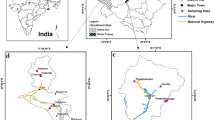Abstract
From March 2007 to March 2009 we quantified plant diversity at Chilapatta Reserve Forest in Terai Duars in the Indian eastern Himalayas. We sampled stratified random nested quadrats. Species richness was 311, representing 167 genera and 81 families. The species diversity index and concentration of dominance of the forest were 2.20 and 0.0072, respectively. Shannon-Wiener index and evenness indices were 4.77 and 1.44, respectively. The Importance Value Index (IVI) of species ranged from 0.13 to 37.94. The estimated diversity indices indicated heterogeneity of the forest in its composition, structure, function and dynamics. Rich forest plant diversity supports the need for continued conservation of tropical forests.
Similar content being viewed by others
References
Anonymous. 2001. 4 th Working Plan for the Forests of Cooch Behar district and Jalpaiguri district (Part) Comprising Cooch Behar Forest Division and Cooch Behar S. F. Division. Volume I, 2000-01 to 2009-10. Darjeeling: Divisional Forest Officer, Working Plans (North) Division, p.180.
Anonymous. 2010a. Global Forest Resources Assessment 2010: Main Report. FAO Forestry Paper 163. Rome, Italy, p.340.
Anonymous. 2010b. Metrological Annual Report. Tobacco Regional Research Centre, Dinhata, Cooch Behar (West Bengal). p.53.
Anonymous. 2011. State of the World’s Forest. Rome: FAO, p.163.
Ashton PS. 1964. A quantitative phytosociological techniques applied to tropical mixed rainforest vegetation. Malaysia Forestry, 27: 304–307.
Banerjee SK, Nath S, Banerjee SP. 1986. Phytosociology and soil characteristics of forests in eastern Himalayas. Indian Journal Tropical Agriculture, 4: 116–125.
Bradshaw CJA, Sodhi NS, Brook BW. 2009. Tropical turmoil: a biodiversity tragedy in progress. Front Ecol Environ, 7: 79–87.
Campbell DG, Stone IL, Rosas AJr. 1992. A comparison of phytosociology and dynamics of three flood plains (Varzea) forests of known age, Rio Jurua, Western Brazilian Amazon. Bot J Linn Soc, 108: 213–237.
Champion HG, Seth SK. 1968. A Revised Survey of the Forest Types of India. New Delhi: Manager of Publications, p.404.
Chauhan SK, Gupta N, Ritu Yadav S, Chauhan R. 2009. Biomass and carbon allocation in different parts of agroforestry tree species. Indian Forester, 135: 981–993.
Cintron G, Novelli YS. 1984. Methods for studying mangrove structure. In: The Mangrove Ecosystem Research Methods (Eds. Snedaker, C. and Snedaker, G.), UNICSO. 251p.
Dash PK, Mohapatra PP, Rao YG. 2009. Diversity and distribution pattern of tree species in Niyamgiri hill ranges, Orissa, India. Indian Forester, 135: 927–942.
Devi LS, Yadava PS. 2009. Aboveground biomass and net primary production of semi-evergreen tropical forest of Manipur, north-eastern India. Journal of Forestry Research, 20: 151–55.
Ferreira LV, Prance GT. 1998. Species richness and floristic composition in four hectares in the Jau National Park in upland forests in Central Amazonian. Biodiversity Conservation, 7: 1349–1364.
Galav PK, Katewa SS, Chaudhary BL, Jain A. 2005. Phytosociological studies on the grassland community of southern Aravalli hills of Rajasthan. Indian Forester, 131: 493–952.
Gardner TA, Barlow J, Chazdon R, Ewers RM, Harvey CA, Peres CA, Sodhi NS. 2009. Prospects for tropical forest biodiversity in a human-modified world. Ecology Letters, 12: 1–21.
Gentry AH. 1990. Floristic similarities and differences between southern Central America and Upper and Central Amazonia. In: Gentry, A. H. (ed.), Four Neotropical rainforests. New Haven, USA: Yale University Press, pp. 141–157.
Hartshorn GS. 1990. An overview of Neotropical forest dynamics. In: Gentry, A. H. (ed.), Four neotropical rainforests. New Haven, USA: Yale University Press, pp. 585–599.
Jamir SA, Pandey HN. 2002. Status of biodiversity in the sacred groves of Jaintia hills, Meghalaya. Indian Forester, 128: 738–44.
Kareiva P, Watts S, McDonald R, Boucher T. 2007. Domesticated nature: shaping landscapes and ecosystems for human welfare. Science, 316: 1866–1869.
Khan NL, Menon S, Bawa KS. 1997. Effectiveness of the protected area network in biodiversity conservation, a case study of Meghalaya State. Biodiversity and Conservation, 6: 853–868.
Kumar A, Marcot BG, Saxena A. 2006. Tree species diversity and distribution patterns in tropical forests of Garo hills. Current Science, 91: 1370–1381.
McIntosh RP. 1975. H.A. Gleason ‘Individualistic Ecologist’ (1882–1975) His contributions to Ecological theory. Bull Torrey Bot Club, 102: 253–273.
Menhinick EF. 1964. A comparison of some species diversity indices applied to samples of field insects. Ecology, 45: 858–861.
Myers N, Mittermeier RA. 2000. Biodiversity hotspots for conservation priorities. Nature, 403: 853–854.
Newaz MS. 2006. Diversity and composition of tree species regeneration in the secondary forests of Chittagong, Bangladesh. Indian Forester, 132: 1419–1428.
Odum EP. 1971. Fundamentals of Ecology (3rd edn.). Philadelphia: WB Saunders Co., p.574.
Ojo LO, Ola-Adams BA. 1996. Measurement of tree diversity in the Nigerian rainforest. Biod Cons, 5: 1253–1270.
Pande PK. 2001. Litter nutrient dynamics of Shorea robusta Gaertn. plantation at Doon Valley (Uttaranchal), India. Indian Forester, 127: 980–994.
Parthasarathy N, Sethi P. 1997. Tree and liana species diversity and population structure in a tropical dry evergreen forest in south India. Trop Ecol, 38: 19–30.
Paul SC. 2004. Land use effects on soil characteristics of Terai region of West Bengal. M. Sc. Thesis. Uttar Banga Krishi Viswavidyalaya, West Bengal, India. Unpubl. 58p.
Pielou EC. 1975. Ecological Diversity. New York: John Wiley and Sons, p.165.
Raunkiaer C. 1934. The Life Forms of Plants and Statistical Plant Geography. Oxford, U. K: Oxford University Press, p.632.
Reddy CS, Pattanaik C, Mohapatra A, Biswal AK. 2007. Phytosociological observations on tree diversity of tropical forest of Similipal Biosphere Reserve, Orissa, India. Taiwania, 52: 352–359.
Richards PW. 1996. The Tropical Rain Forest: An Ecological Study. Cambridge: Cambridge University Press, p.575.
Shannon CE, Weiner W. 1963. The Mathematical Theory of Communication. Urbana, Illinois, USA: University of Illinois Press, p.111.
Sharma GD, Bhattacherjee S, Sinha M, Das AK. 2002. Status of plant biodiversity of Cachar district and is conservation. Journal of Economic and Taxonomic Botany, 26: 94–1001.
Simpson EM. 1949. Measurement of diversity. Nature, 163: 688.
Singh JS. 2002. The biodiversity crises: a multifaceted review. Current Science, 82: 638–647.
Tiwari BK, Barik SK, Tripathi RS. 1998. Sacred groves of Meghalaya-conserving the sacred for biodiversity management. In: Ramakrishnan, P. S., Saxena, K. G. and Chandrashekara, U. M. (eds), Conserving the sacred groves for biodiversity management. New Delhi, India: Oxford and IBH Publishing Co., pp. 253–262.
Author information
Authors and Affiliations
Corresponding author
Rights and permissions
About this article
Cite this article
Shukla, G., Biswas, R., Das, A.P. et al. Plant diversity at Chilapatta reserve forest of Terai Duars in sub-humid tropical foothills of Indian eastern Himalayas. Journal of Forestry Research 25, 591–596 (2014). https://doi.org/10.1007/s11676-014-0452-3
Received:
Accepted:
Published:
Issue Date:
DOI: https://doi.org/10.1007/s11676-014-0452-3




